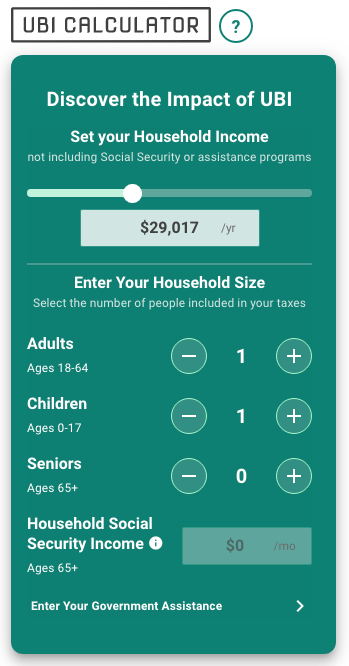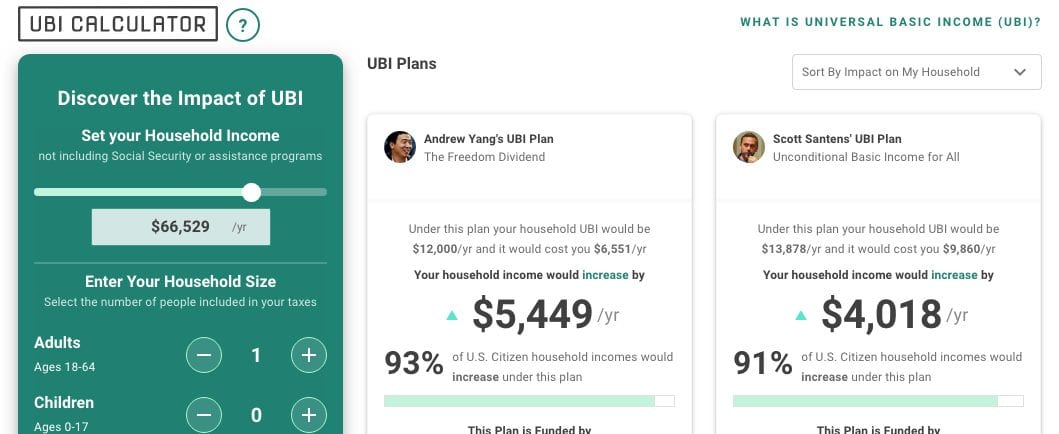With help from an incredible team of software developers, economists, and supporters, we have created the UBIcalculator. The project has taken over a year to construct.

This is what UBIcalculator looks like
UBIcalculator is a very simple yet powerful tool for understanding and communicating how various American basic income plans would likely pan out for…
- Your bottom line: Will your household gain or lose money after implementing different versions of UBI?
- The American public’s bottom line: How many people would be lifted above the poverty line, what percentage of Americans would gain income versus paying in, how would it be funded, and how much, if any, deficit spending would be utilized and why?
How to Use UBIcalculator
- Enter your household income, family dynamic, and, if applicable, Social Security and government assistance (welfare) income into the calculator.
- Peruse the plan list to compare the headline numbers (how it affects your income, the number of Americans who gain income, and deficit spending utilized). Sort by any of these factors to see which plan ranks highest in each category.
- Click on any individual plan to learn more details about its effects, how it is funded, and why the plan author designed their basic income this way.
- Adjust the income scroll bar or change your household inputs at any time to see the numbers react in real-time.
- If you want to display a widget of any specific plan on your website, there is an embed code down at the bottom of each one that will let people use the calculator on your site.
- Go as surface level or deep as you want. You can discover the highest potential return for you and your family.
- Now you have a great idea of how UBI could impact you and the rest of the United States, and you have a convenient tool you can share to avoid getting into drawn-out economic debates. Just share the knowledge with this link.
What is Next for UBIcalculator?
This is Version 1.0. It is very powerful, but there are plans to keep improving.
Version 2 goals:
- Include more UBI funding mechanism options (wealth tax, land value tax, corporate tax, etc.)
- Policy-Maker Mode: A platform where anyone can create and submit a UBI plan of their own (limited by specific “Do No Harm” principles that would not allow for anything draconian or irresponsible to be proposed)
- Create a database of plans with improved searching/sorting/upvoting mechanisms to allow the best and most popular plans and ideas to rise to the top.
Things to Keep in Mind
- All calculations are estimates.
- We strove to do all of the calculations as conservatively as possible, so the results you are seeing are theoretically the worst-case scenarios.
- In order to retain maximum credibility, no plans get special treatment in any way.
Why I Made UBIcalculator
- TRANSPARENCY: To cut through misinformation. I am tired of seeing pundits, politicians, and other people with various agendas both for or against UBI telling people what to believe. I want the American public to be able to know about the actual proposals and what is possible directly from the mathematical source, with no spin or propaganda.
- VIRALITY: I believe in the grassroots. For that, the public needs to be informed and empowered to act, so I made UBIcalculator as simple to use and shareable as possible.
- UNITY: To help the UBI movement coalesce around the best plans and opportunities, to hold everybody (yes, even Andrew Yang) accountable and push them to improve their plans where possible, and to create an avenue for other candidates and political figures to quickly study and propose their own versions of UBI if they so choose.
Author: Conrad Shaw



A look at the UBI calculator for USA makes it obvious that robust incomes (as seen from countries with weaker economic status) will still have increments in their values. A point that may be menacing to fragile economies, since mechanisms of wealth transfer, as already in place for large pension funds and rich private investors, may stress further weaker economies; hence, care with high UBI values, in rich countries, may be a theme of global concern.